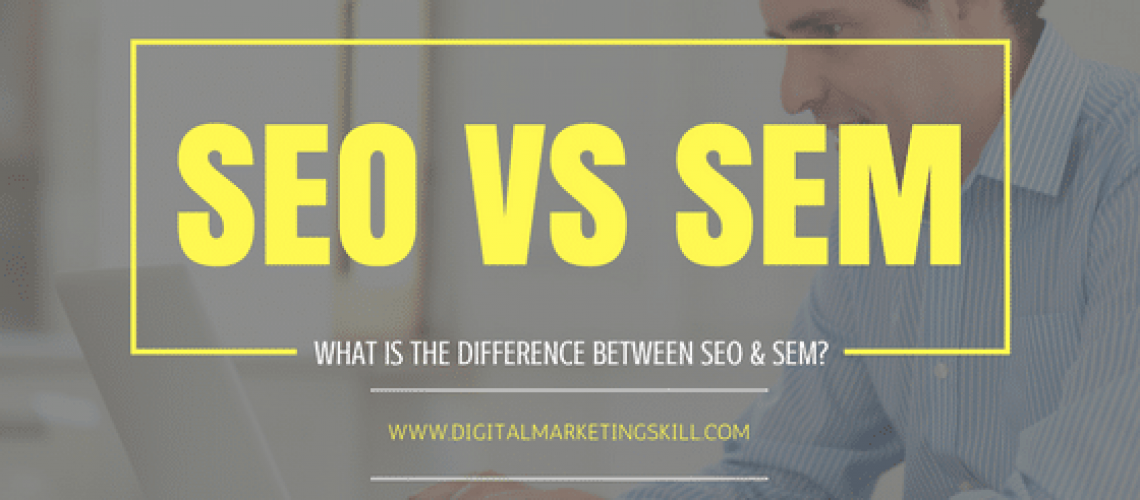Marketing has evolved as the language we express as online marketers. SEO and SEM is one of those misunderstood terms in digital marketing. Both terms are often used interchangeably, which makes them less utilised sometimes.
It is important to understand the difference between the two terms to effectively maximise all there is to them.
And that is why I will be clearing all misconceptions and helping you to understand the difference between SEO (Search Engine Optimization) and SEM (Search Engine Marketing).
We have a course that teaches SEM and SEO for beginners, you can click here to learn more about our digital marketing course and how you can grow your business using the various digital tools.
The difference between SEO and SEM is simply that Search Engine Optimization is part of Search Engine Marketing or Search Marketing as it is widely known. Both processes aim at enhancing visibility in search engines.
SEO is about optimising your website to get better rankings in the search results while SEM goes beyond SEO and includes PPC (Pay-per-click) advertising.
Let’s look at these two search engine terms in more details.
Search Engine Optimization (SEO)

To clearly state out the difference between SEO and SEM, it is important to start with the meaning of SEO.
What is SEO?
Get 50% Discount to Master ALL Aspects of Digital Marketing That Can Earn You $2,500 - $5,000 a month (Even if you are a complete beginner!)
Our students that intentionally implement what they learn from our digital marketing course make back the entire course fee within a single month or more after completing our course because our course gives them many income generating options with unlimited earning potential with no age or location barrier. The best part is no technical skills are required.
An opportunity to change your lifestyle and make money working from anywhere in the world. The results our students get from our digital marketing course prove this could be applied to any market or country and that it is designed for any skill level and work background.
*By signing up, you agree to our privacy policy and terms of service.
SEO is the process of optimising your website for the purpose of getting free quality traffic from search engines.
An optimised website is more easily recognised by Search Engine Crawlers and this improves the chances of ranking higher for relevant keywords in SERPS.
The world of SEO is ever-changing and evolving to keep up with Google’s algorithms, but one thing remains constant: SEO is made up of 3 major factors which determine your SEO efforts, they are Technical, On-page, and Off-page activities.
Technical SEO
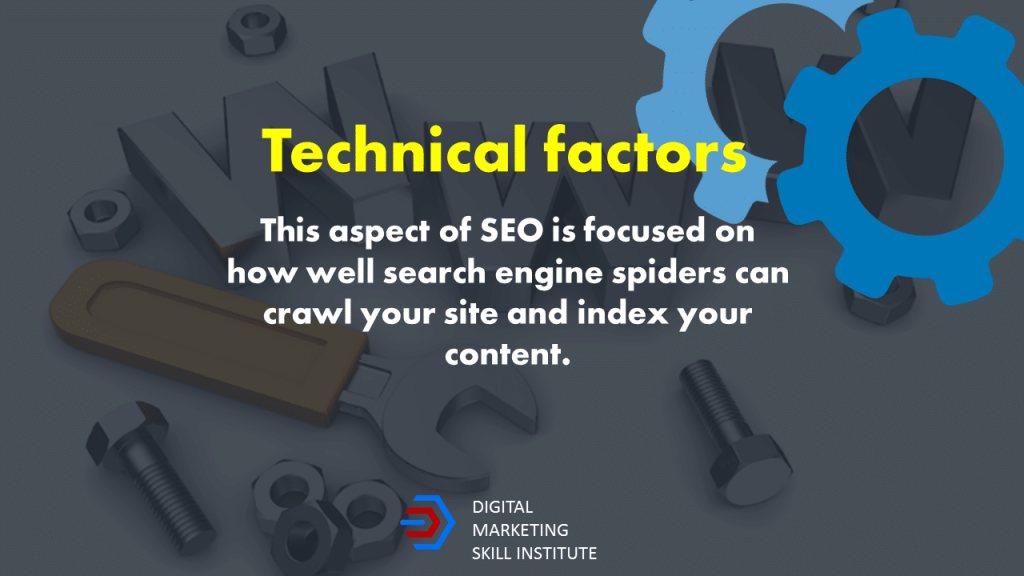
This aspect of SEO is focused on how well search engine spiders can crawl your site and index your content.
- Optimized page speed to ensure your pages are loading pretty fast on both PC and mobile device.
- Proper URL permalink structure.
- Free of spam.
- Fixed broken links on your website to avoid 404 error pages.
- Have a working XML sitemap to notify Google of website new updates.
- Mobile responsive isn’t an option anymore.
- Add your site to webmasters or search console, this is one of the foundational steps to getting on any search engine.
On-page SEO
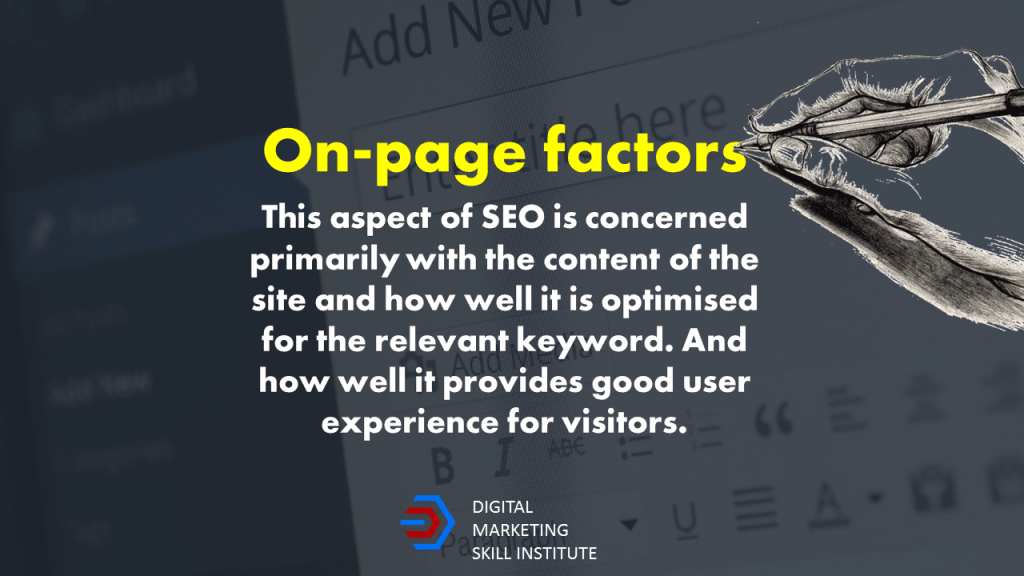
This aspect of SEO is concerned primarily with the content of the site and how well it is optimized for the relevant keyword. And how well it provides a good user experience for visitors.
- Optimized metadata, including the page title tag, meta description, heading tags, and image ALT tag, which incorporates target keywords.
- Well-written and optimized page copy that incorporates target keywords.
- Simple and well-formatted page URLs with selective keywords.
- Social sharing integration within your content.
Off-page SEO
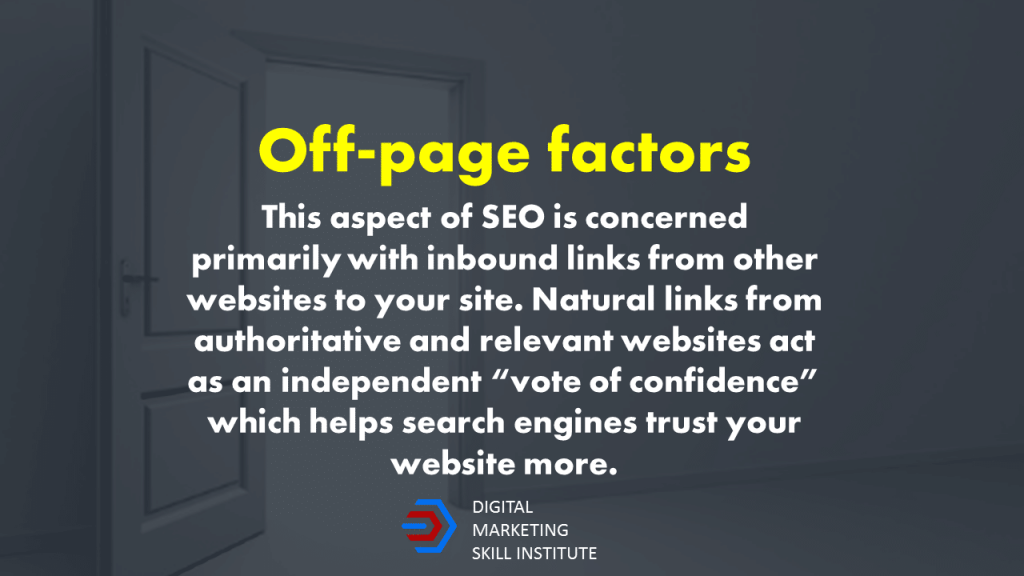
This aspect of SEO is concerned primarily with inbound links from other websites to your site. Natural links from authoritative and relevant websites act as an independent “vote of confidence” which helps search engines trust your website more.
- Link building to attract and obtain quality inbound links (aka “backlinks“). This makes up the majority of off-page SEO
- Social signals (e.g., increasing traffic to a website from social media sharing)
- Attracting attention from social bookmarking sites like Reddit and Digg.
Benefits of SEO (Search Engine Optimization)
1. Increased Traffic
Top positions on the search engine result pages receive a majority of the impressions and clicks, so ranking in these top positions can result in significant traffic increases for your website.
SEO also focuses on creating informative and keyword relevant title tags and meta descriptions, which show up in the result pages.
Having optimized tags and descriptions helps to increase click-through rate, which also promotes increases in qualified web traffic.
READ: How to Drive Traffic To Your Website Through Search Engine Optimization (SEO)
2. ROI (Return on Investment)
SEO provides trackable and quantifiable results, regardless of whether you are an e-commerce or non-eCommerce site so there are no qualms when it comes to ROI.
SEO agencies are able to track nearly every aspect of their strategy, like increases in rankings, traffic and conversions.
Comprehensive analytics also provide the ability to drill down at a granular level and see demographic information and other engagement metrics for individuals who have interacted with your website.
For E-commerce sites, SEO agencies can see which paths users take in order to complete a sale, all the way down to which keyword they used to search for you prior to purchasing.
For non-eCommerce sites, you can attribute values to your lead conversions, like a ‘contact us’ form fill-out, and calculate the value of your SEO strategy that way.
3. Cost-effectiveness
SEO is one of the most cost-effective marketing strategies because it targets users who are actively looking for your products and services online. SEO’s inbound nature helps businesses save money as opposed to outbound strategies like cold-calling.
[bctt tweet=”SEO is one of the most cost-effective marketing strategies because it targets users who are actively looking for your products and services online. SEO’s inbound nature helps businesses save money as opposed to outbound strategies like cold-calling.” username=”DMSInstitute”]
While cold-calling can still be an effective strategy, the leads generated cost 61% more than leads generated by an inbound strategy like SEO.
And since SEO also targets users who are actively searching for products and services like yours, the traffic resulting from SEO is more qualified than many other marketing strategies, resulting in cost-savings for companies.
4. Increased Site Usability
To make your website easier to navigate for search engines, SEO simultaneously helps to make your website more navigable for users as well.
SEO consists of rearranging the site’s architecture and links to make pages within the website easier to find and navigate.
This not only makes it easier for search engines to crawl your site and find pages but also makes it easier for users to find information on your website as well.
5. Brand Awareness
Since top position rankings result in significant impressions, having your website in these top positions on the result pages translates to more exposure for your website.
Plus, being on the first page for your targeted keywords not only helps users to associate your brand with those keywords, but it instils trust since companies on the first page are generally perceived to be more trustworthy.
The more your pages and content rank in high positions in the search engines, the more chances you have for users to see your content and associate with your brand.
In essence, a large part of SEO is creating valuable, high-quality content (e.g., blog articles and web page copy) that your target audience will find helpful.
Over time, this results in increased quality organic traffic to your website, more opportunities for inbound links and, most importantly, more conversions and sales.
Be sure to pay attention to these technical, on-page and off-page tactics to ensure your landing pages, web copy and blog articles are optimized for search.
In one of my previous posts, I explained what is SEO and why is it important. I have also outlined the most important SEO tips and SEO tools you will need.
Search Engine Marketing (SEM)
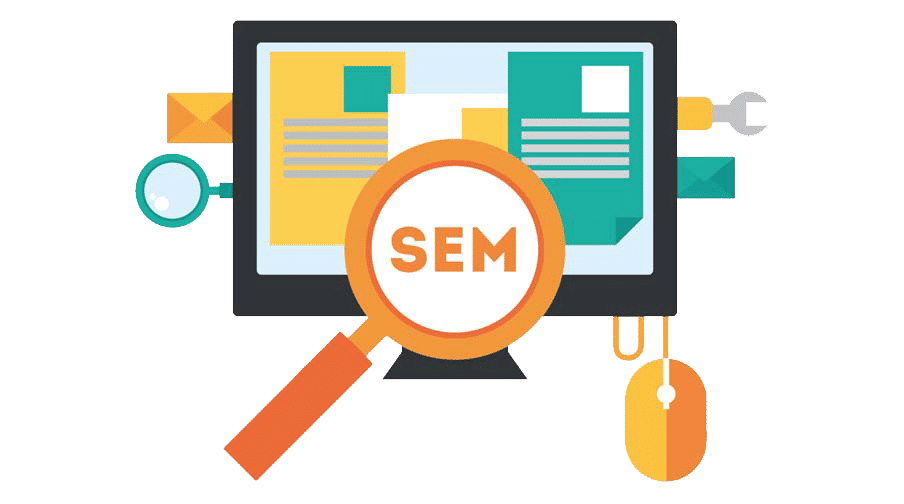
Let’s start by defining Search Engine Marketing.
What is SEM?
According to Wikipedia, Search engine marketing (SEM) is a form of Internet marketing that involves the promotion of websites by increasing their visibility in search engine results pages (SERPs) primarily through paid advertising.
SEM may incorporate search engine optimization (SEO), which adjusts or rewrites website content and site architecture to achieve a higher ranking in search engine results pages to enhance pay per click (PPC) listings.
Most search engines have an ad platform for search engine marketing.
The most well-known (and effective) platform to use is Google AdWords. Bing Ads and Yahoo Search Ads are also both SEM platforms that you can use.
It’s important to note that—while all SEM platforms utilize a pay-per-click (PPC) advertising model—not all PPC is SEM.
Facebook Ads and other social media ad platforms, for example, are pay-per-click platforms that do not fall under the SEM category.
Instead of showing your ads to people who are searching for similar content like search ads do, social media sites introduce your product to people who happen to just be browsing through their feeds.
These are two different types of online advertising.
But…
Since we are focusing on Search Engine Marketing (Advertising through search), then here are some of SEM features and benefits to be considered.
Benefits of Search Engine Marketing (SEM)
1. Geotargeting
Whether you want to reach potential clients in your own backyard or halfway across the world, you can target searchers down to their city-level location (although that level of pay per click targeting works better in North America than other parts of the world). Choose to target a radius around a zip code, metro area, state, country, or add in regions of interest.
2. Control
The levels of control over paid search with platforms like Google AdWords and Bing Ads are truly astonishing, giving you control over:
- What keyword searches trigger your ad.
- Physical location of the searcher (geo-targeting mentioned above).
- Time of day.
- Day of week/season.
- Device type (e.g. computer vs. phone – and which type of phone).
- Network (e.g. Google only or its Search or Display Networks)
- Ad position and more
3. Pay Per Action
Paid search is commonly referred to as pay per click advertising because the most common form of ad buy with paid search is that you only pay when someone clicks on your ad.
We like to refer to traffic from paid search as “doubly targeted” because the person has to:
Type in something related to what you sell, and Look at all the information on the screen before deciding to click on your ad because she or he expects it to provide the information she or he seeks.
4. Free Exposure
The corollary of only paying when someone clicks on your ad in the pay per click model is that you get all the additional views of your ad and company name for free. This is just one reason that makes paid search particularly valuable for branding campaigns.
Other benefits are:
- Increase brand awareness and brand equity of products.
- Increase Visibility – Increase in website traffic.
- Advertise to an audience that’s already interested in you.
- Increase in targeted leads.
- Target your ads to users based on languages and locations.
- Competition advantage – Marketers can enable users to select their product over their competitors.
- Greater ROI — Compared to other advertising media, paid search strategies are more efficient.
For all the reasons listed above and more, the single most important benefit of paid search engine marketing is just that it works.
That’s why U.S. advertisers spend more than $12 billion per year on paid search, including top advertisers spending more than $8 million per month on Google AdWords alone.
SEO vs SEM (Difference explained with images)
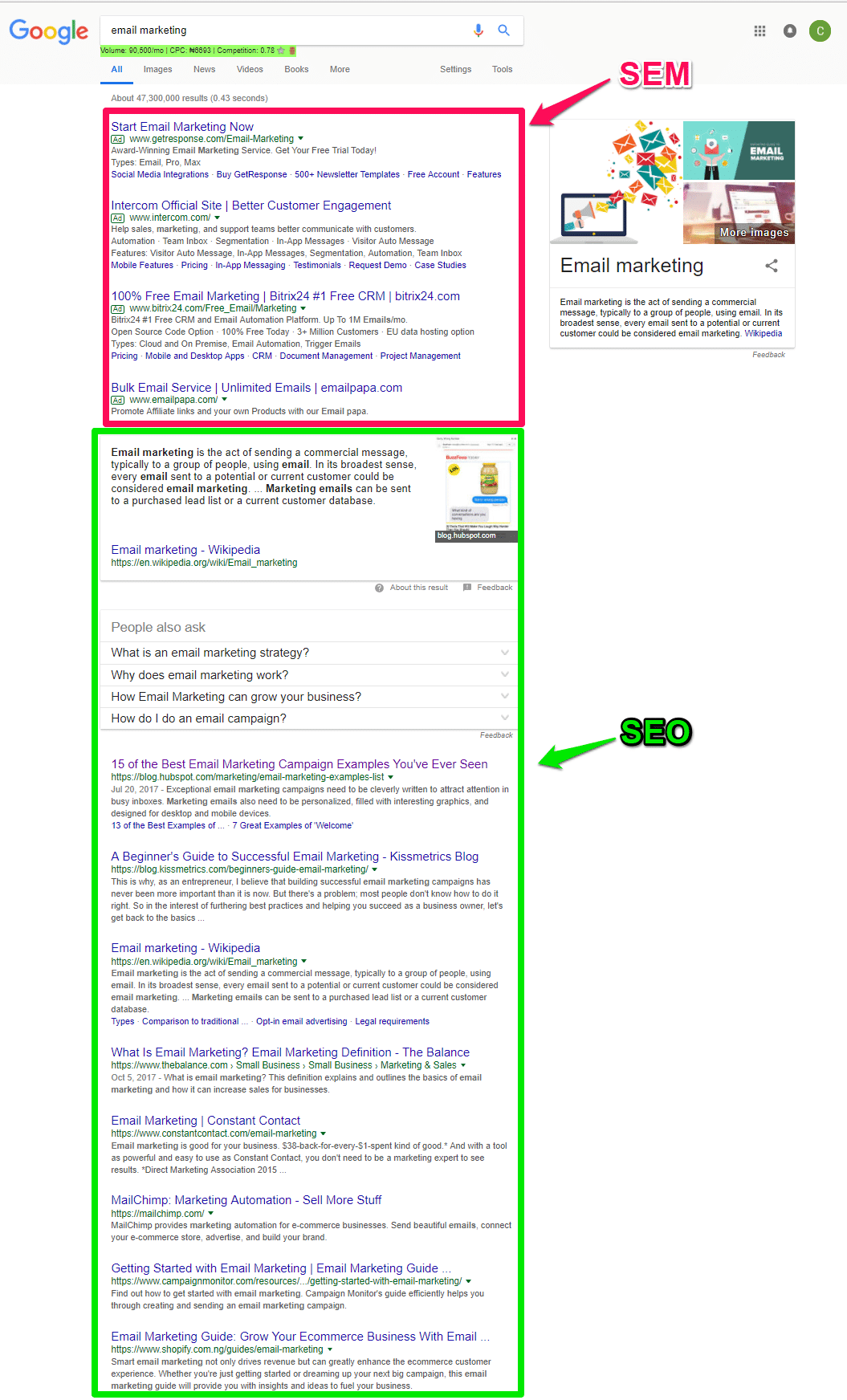
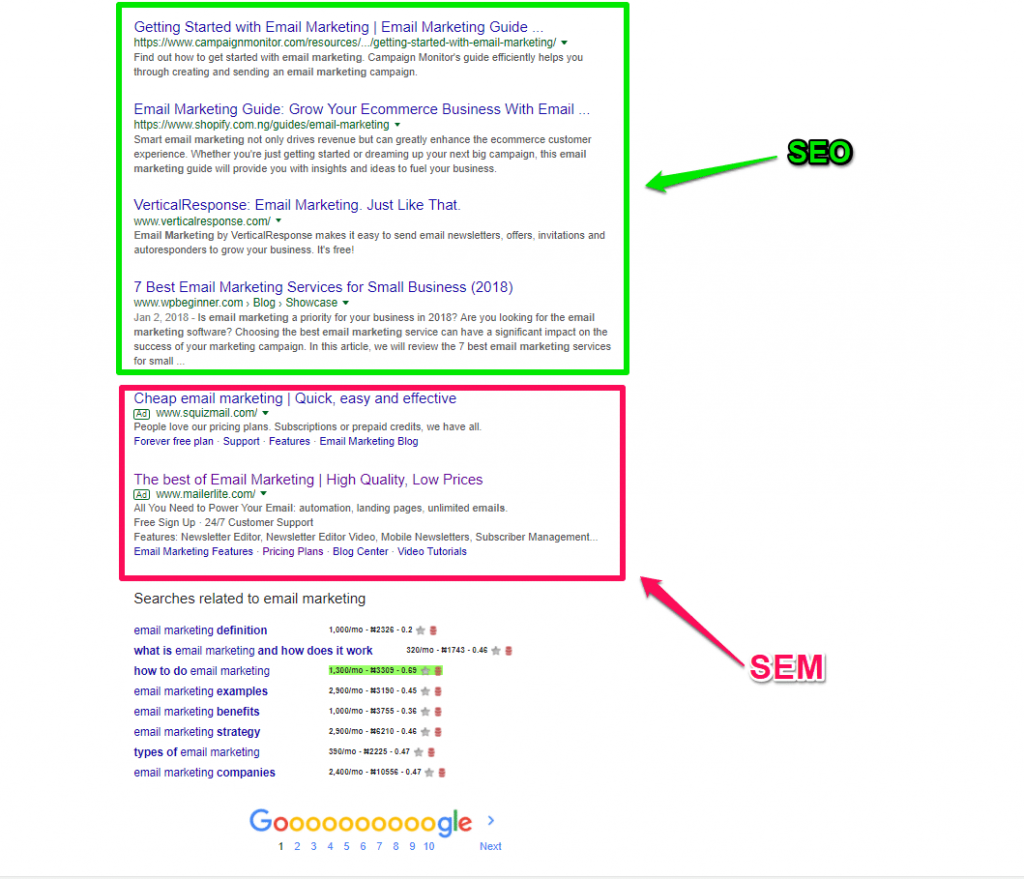
Difference between SEO and SEM?
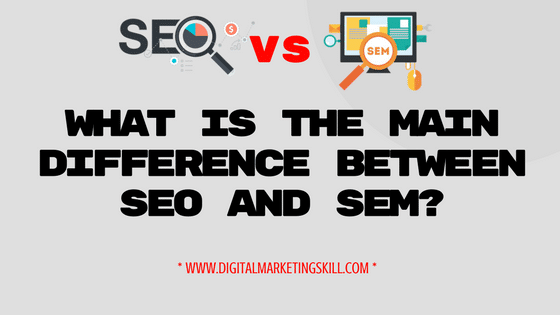
The main difference between these two digital marketing terms is that search engine optimisation is simply a component of search engine marketing.
As mentioned above, SEM includes components of paid search, such as PPC and also SMM (social media marketing).
It is important to note that you should never use the terms SEO and SEM interchangeably because although they work hand in hand, they are not the same term.
In essence;
According to the screenshots shared above…
You would deduce that SEM (Search Engine Marketing) is ranking for relevant keywords by paying (CPC bids).
Meanwhile, SEO is just a component of SEM that allows you to rank your content/website for the same keyword (FREE)!
Meanwhile, SEO is just a component of SEM that allows you to rank your content/website for the same keyword (FREE)!
How Do SEO and SEM Work Together?
SEO (Search Engine Optimization) and SEM (Search Engine Marketing) work together in a digital marketing strategy to enhance visibility, drive traffic, and achieve marketing goals effectively. SEO focuses on optimizing a website to improve organic search rankings over time through activities like keyword research, content optimization, link building, and website structure improvements.
On the other hand, SEM involves paid advertising to gain immediate visibility and drive targeted traffic through methods like pay-per-click (PPC) advertising. Therefore, when you combine SEO and SEM strategies, businesses can benefit from immediate visibility in search engine results pages (SERPs) through SEM while working towards long-term growth and organic traffic with SEO. This integration allows for a comprehensive digital marketing approach that maximizes results by leveraging the strengths of both strategies.
How to Combine SEO and SEM in Your Marketing Strategy
To effectively combine SEO (Search Engine Optimization) and SEM (Search Engine Marketing) in your marketing strategy, you can follow these key steps outlined in the provided sources:
1. Allocate Paid Search Spend Using Organic Search Performance Insights: Start by using keyword research to identify areas where you are underperforming in organic search. This helps you understand your target audience better and reduces unnecessary ad expenditures.
2. Inform Your Content Strategy With SEM Keyword Performance: Identify your most valuable paid terms and collaborate with content writers to incorporate these high-value terms into your organic content. This integration enhances the effectiveness of both SEO and SEM efforts to yield great results.
3. Perform Competitive Research Using Paid & Organic Insights: you need to understand your competitors and categorize them accordingly. When you do that, you will be able to analyze their strategies and compare them with your own paid and organic research to gain a comprehensive view of the competitive advantage.
Conclusion
With all the above explanation, I hope it gives you a clearer understanding of SEM vs SEO.
So, no need to be confused anymore as you now know all there is about the two.
SEM offers a set of marketing methods that increase the visibility of your website in search engine results pages (SERPs).
As previously noted, processes like Search Engine Optimization (SEO) and Pay Per Click (PPC) advertising make up SEM. And both play a crucial role in enhancing your business’s online visibility and accessibility.
Our 90% practical digital marketing training course is designed to equip you with the vital skills for success in those two areas.
You can click here to attend our digital marketing training course today.
Or use the link below => https://digitalmarketingskill.com/digital-marketing-training-course/
Faqs
How Long Does It Take to See SEM Results?
To see SEM (Search Engine Marketing) results, it typically takes 4-12 months for SEO (Search Engine Optimization) to work effectively. Implementing SEO strategies is a long-term process that requires consistency and patience to yield significant results. By focusing on low-difficulty keywords, fixing technical SEO errors, optimizing content, and improving unhelpful content, you can expedite the route to SEO success and see improvements in your SEM performance over time.
Why is SEO more important than SEM?
SEO is often considered more important than SEM due to its long-term benefits and cost-effectiveness. SEO focuses on improving organic search rankings over time, leading to sustained visibility and traffic without ongoing ad spend. While SEO takes time to see results, the long-term return on investment is significant. In contrast, SEM provides immediate visibility through paid ads but requires continuous investment to maintain traffic levels. SEO’s focus on organic growth, sustainable results, and cost efficiency makes it a crucial component of a comprehensive digital marketing strategy.
What’s the Cost of SEO vs. SEM?
While SEO focuses on optimizing a website to improve organic search rankings, SEM involves paid advertising to increase visibility in search engine results. The cost of SEM can be more immediate and directly tied to the advertising budget, while SEO costs are typically ongoing and require a longer-term investment to see significant results. Ultimately, the choice between SEO and SEM depends on the specific goals, budget, and timeline of a digital marketing strategy.
RELATED ARTICLES:
- 7 Common SEO Mistakes To Avoid And How To Fix Them
- Effective SEO Keywords | 7 Tips To Choosing The Right SEO Keywords
- 40 Best Content Marketing Tools To Jump-start Your Digital Content
- 9 Easy Website SEO Tips To Rank Higher On Search Engine
- Google+ Lead Generation Guide | 8 Effective Ways To Generate Leads
- Search Engine Optimization (SEO) | A Complete Beginner Guide To Ranking Your Website
- Google Adwords Hacks | 12 Tips For Improving Your AdWords Campaign Performance

